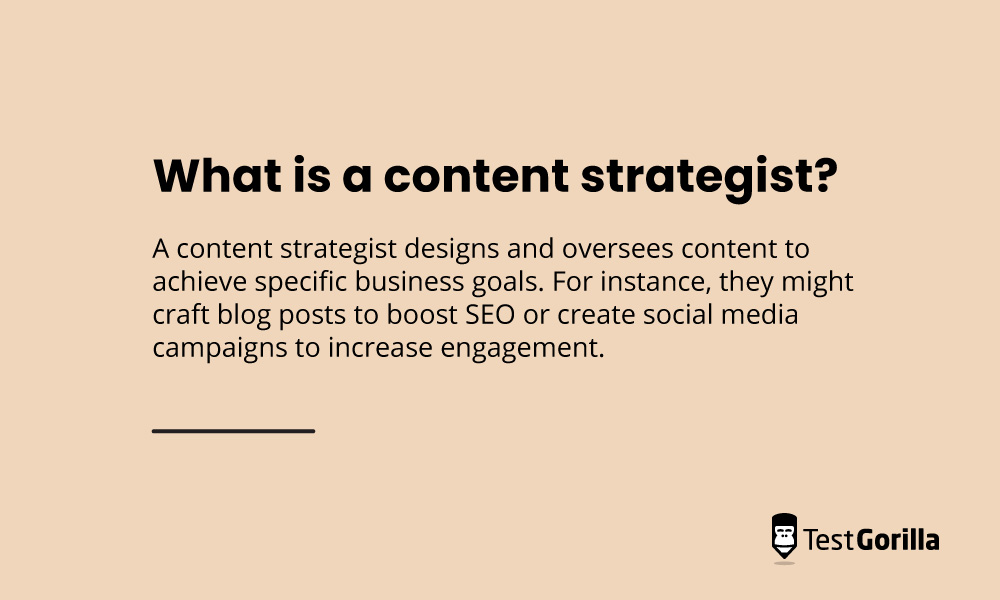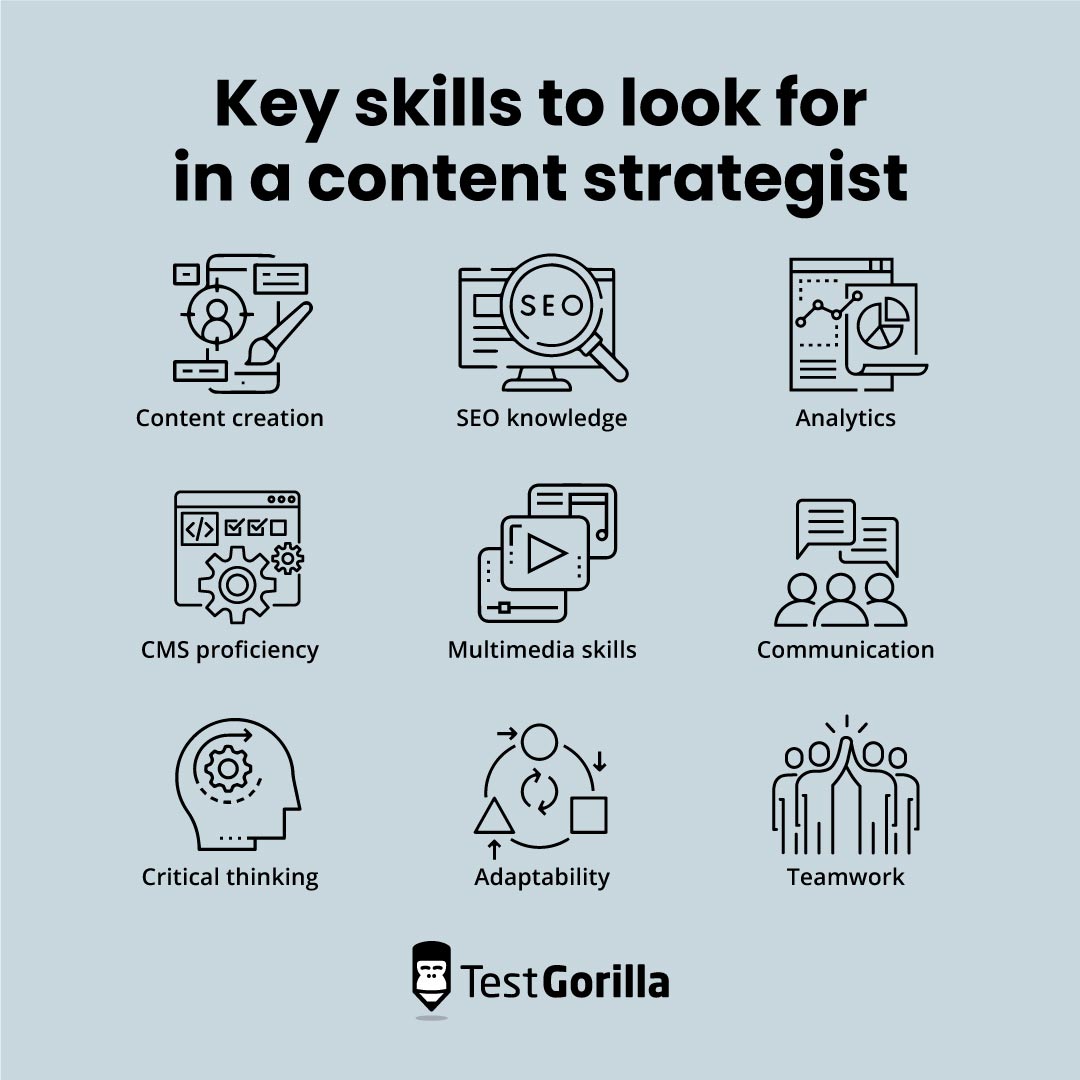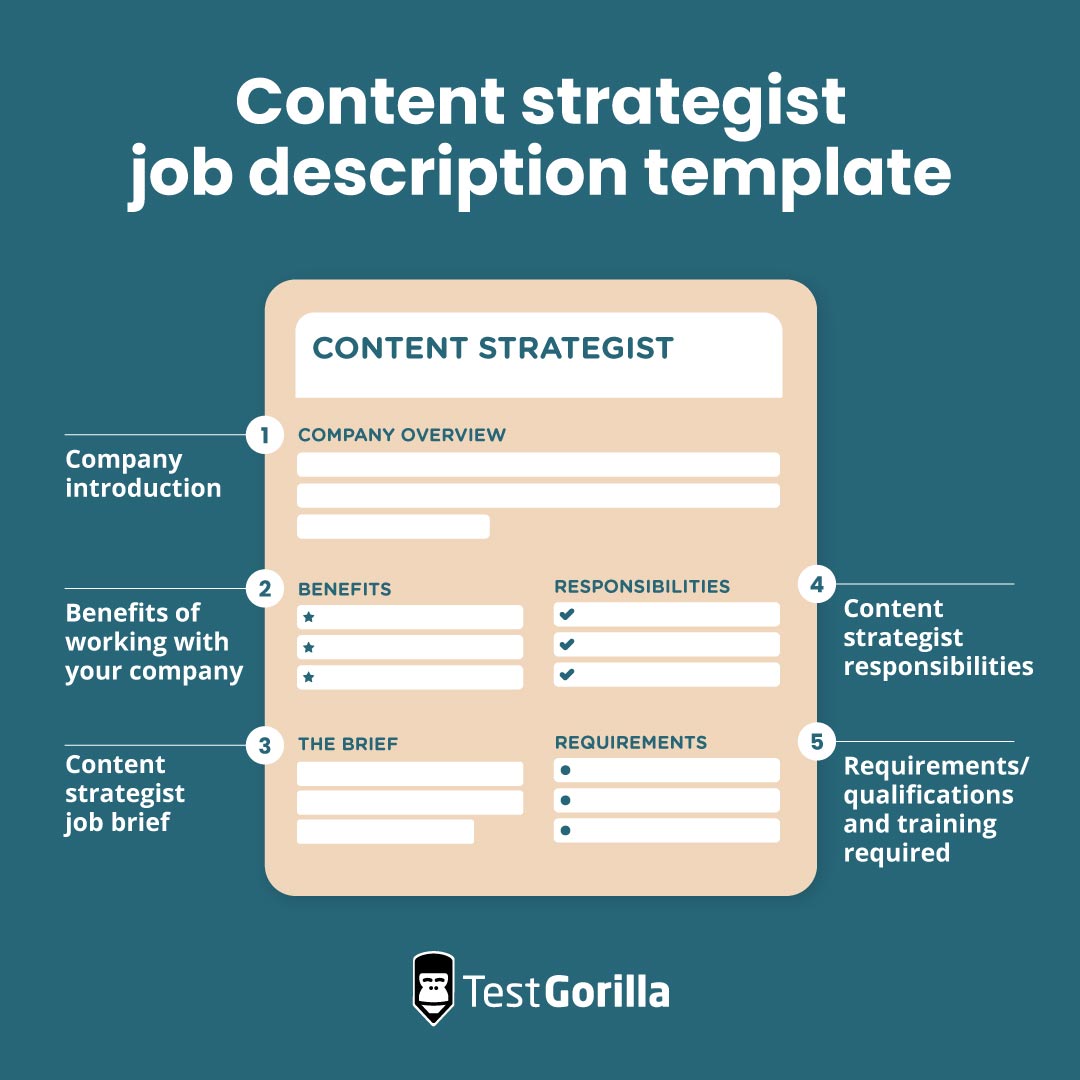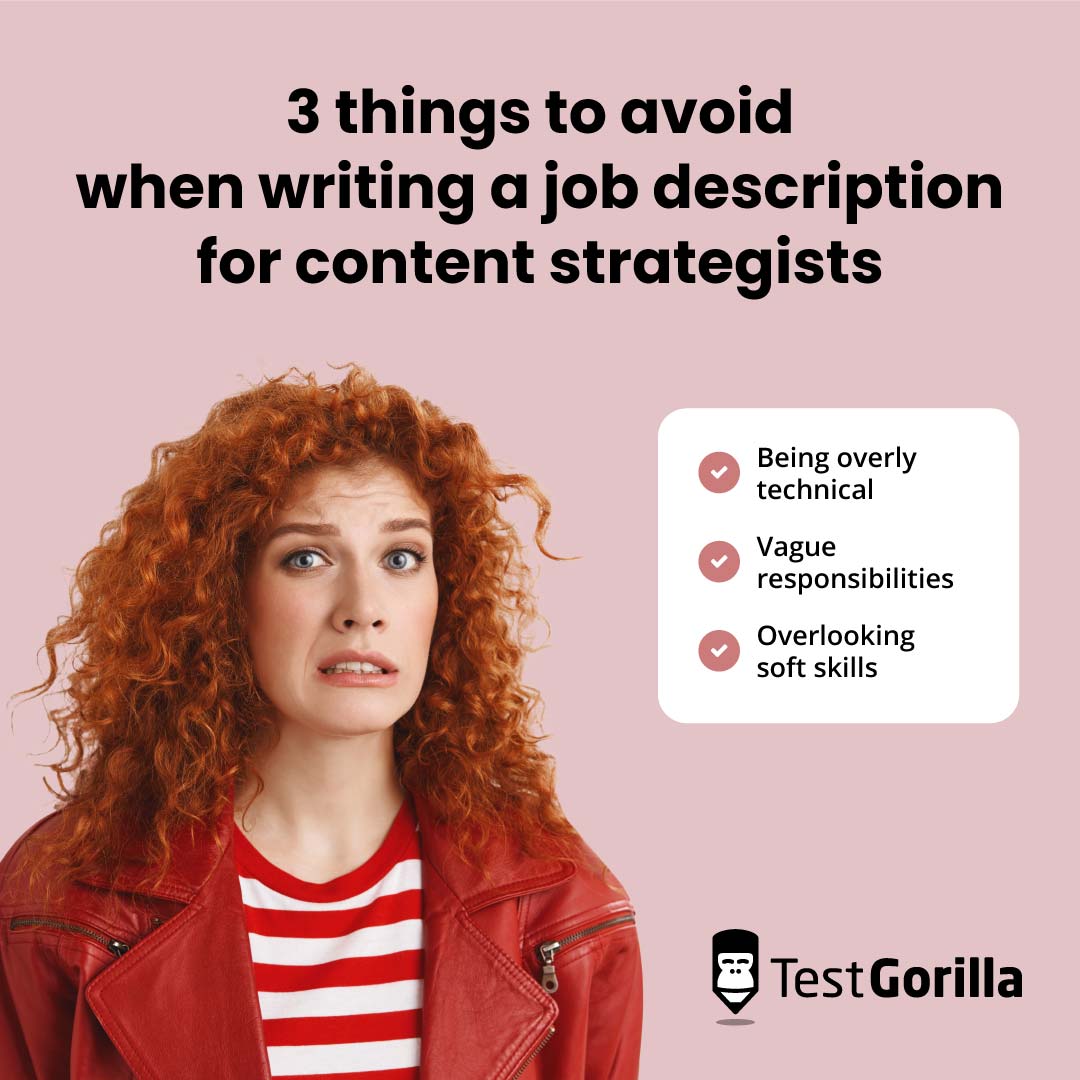Writing a great job description is vital for attracting a talented content strategist to your organization. However, it’s all too easy to paint an incomplete picture of the role by overemphasizing technical skills and not focusing on the essential soft skills necessary for success, like communication and teamwork.
Failing to provide a well-rounded view can lead to the costly mistake of hiring a candidate who underperforms and doesn’t mesh with your existing teams.
To avoid these resource-heavy mistakes, we explain how to write an effective content strategist job description and give you a free template to kickstart your process.
Table of contents
- What is a content strategist?
- Key skills to look for in content strategists
- How to write an effective content strategist job description
- Content strategist job description template
- Three things to avoid when writing a job description for content strategists
- Next steps: Attracting and assessing content strategist candidates
- FAQs
- Hiring skilled content strategists with TestGorilla
What is a content strategist?
A content strategist designs and oversees content to achieve specific business goals. For instance, they might craft blog posts to boost SEO or create social media campaigns to increase engagement.
They consider where the content will be posted, who it's for, and how it should sound to represent the brand accurately. They also use data, like website traffic or social media involvement, to measure the content's success and adjust strategies accordingly.
Key skills to look for in content strategists
Below we outline nine technical and soft skills content strategists need.
Content creation: Crafting well-researched and engaging content, like writing articles, blogs, or social media posts that resonate with the target audience.
SEO knowledge: Understanding of keywords to optimize content so it ranks high on search engines such as Google.
Analytics: Using tools like Google Analytics to analyze data and understand content performance. For instance, how many people visit a site, how long they stay, and what they click.
CMS proficiency: Knowledge of content management systems (CMS), like WordPress, to publish and manage content online.
Multimedia skills: Relying on basic design or video editing skills to incorporate images, videos, or infographics into content.
Communication: Articulating ideas and feedback clearly – a crucial ability when working with a team or presenting strategies to stakeholders.
Critical thinking: Evaluating large amounts of information to determine what content to produce and how to present it.
Adaptability: Pivoting strategy based on new information or changing trends in content marketing, audience, or product.
Teamwork: Collaborating with writers, designers, marketers, and other team members to bring the content vision to life.
The best insights on HR and recruitment, delivered to your inbox.
Biweekly updates. No spam. Unsubscribe any time.
How to write an effective content strategist job description
Follow these helpful tips to help you write a clear content strategist job description.
Focus on key skills
Skills-based job descriptions focus on skills and responsibilities instead of potentially non-essential degree requirements. For instance, a candidate with a rich portfolio showcasing hands-on content creation will likely provide more value than an inexperienced candidate holding a communications degree.
A skills-based approach attracts a wider and more diverse group of candidates and encourages an inclusive hiring process.
Consult with relevant teams
Teams who interact with or rely on the content strategist can provide firsthand insights into the daily responsibilities, skills, and collaboration needs of the role.
For example, the marketing team might highlight the importance of the strategist's role in SEO and conversion optimization. The design team could emphasize the need for close collaboration on multimedia content.
Lead with your company culture
Putting your company culture first helps attract candidates who not only have the technical skills but also share a genuine connection with the company's mission and values.
For instance, if your company is dedicated to promoting community engagement, a culturally aligned content strategist is more likely to create content that authentically resonates with local communities, amplifying your brand's impact.
Content strategist job description template
Use this content strategist job description template and adjust it to fit your unique needs.
Company introduction
Give a quick rundown of what your organization is all about – its history, values, and mission. Don't forget to share your current goals and future plans to paint a vibrant picture of what it's like to be part of your team.
Benefits of working with [your company]
Highlight the unique advantages of working with your organization, like your competitive compensation and benefits, generous vacation policy, and flexible work options.
Content strategist job brief
[Company name]
Job Title: [For example, Junior Content Strategist, Senior Content Strategist, Content Strategy Manager]
Reports to: [For instance, Content Strategy Manager, Director of Content, Chief Marketing Officer]
Job Type: [Full-time, part-time, on-site, remote, or hybrid]
[Compensation information, including salary and benefits]
Content strategist responsibilities
Develop seasonal or annual content calendars outlining appropriate topics or themes, such as "Beginner's Guide to Topic Y" or "Tips for Successful Z”
Use feedback forms to learn which format (e.g. articles, videos, podcasts) the audience prefers
Ensure every blog post or video retains a consistent and recognizable style, voice, and tone
Make content search-friendly by researching popular keywords with tools like Ahrefs and SEMrush
Use SEO best practices, like optimizing meta titles and descriptions, backlink building, and addressing user intent
Monitor how content performs and adjust strategies accordingly
Collaborate with other departments, such as the design team, to produce and promote content for upcoming campaigns
Regularly refresh content with recent data to keep it relevant
Adjust content by integrating feedback from sources such as social media and comment sections
Requirements/qualifications and training required
High school diploma
Proficiency in content management systems (like WordPress, Contentful, or Drupal)
[2+] years’ experience in content strategy or content creation
Portfolio showing prior content strategy work, including examples of developed content and strategic plans
Three things to avoid when writing a job description for content strategists
Here are three common pitfalls to avoid when making your content strategist job description.
1. Being overly technical
Technical skills are crucial for content strategist roles. That said, you should avoid listing every single tool or software the strategist might encounter. It can make the role seem too specialized and turn away qualified candidates who use different tools. Instead, focus on the core skills needed for success.
2. Vague responsibilities
Simply stating "create engaging content" is too broad. Instead, provide clear and specific duties, such as "developing a quarterly content calendar" or "analyzing content performance metrics." This will help candidates understand the role’s day-to-day expectations.
3. Overlooking soft skills
Ignoring skills like communication, teamwork, and adaptability risks attracting candidates who can’t work cross-functionally or may struggle to adapt to the evolving demands of the role. Instead, highlight soft skills in your descriptions to identify well-rounded candidates.
Next steps: Attracting and assessing content strategist candidates
After creating a well-crafted job description, it’s time to draw in and evaluate candidates to hire a content strategist.
Start by posting your description to popular job boards, social media platforms, and online content communities, like LinkedIn, Reddit, and Superpath (which is specifically for content marketers).
Once you've collected and organized applications, evaluate your candidates with TestGorilla’s all-in-one platform. Create a customized content strategist assessment by combining up to five relevant tests from our extensive library. For example, the Content Strategy test assesses a candidate’s ability to connect with a target audience and boost traffic.
Measure a wide range of hard and soft skills, cognitive abilities, and personality types. You can also add your own custom questions to the assessment. TestGorilla’s one-way video interview feature enables you to use structured interview questions alongside your tailored assessment for a complete view of candidates.
Further reading: 45 content strategist interview questions
FAQs
Does a content strategist write?
Yes, content strategists often write or oversee the writing of content. While they may not be responsible for all content creation like content specialists, they play a crucial role in planning, guiding, and optimizing written content for an overall content strategy.
What is the role of a content strategy lead?
A content strategy lead holds a senior position with strategic and managerial responsibilities. They oversee content strategy development, manage teams, and participate in high-level strategic discussions.
Hiring skilled content strategists with TestGorilla
To create strong job descriptions for content strategists, focus on skills, coordinate with adjacent teams, and highlight your company culture. Following these key steps will attract the right talent for your organization.
Once you have a pool of talented candidates, leverage TestGorilla's versatile testing platform, offering 300-plus tests, to actively engage and evaluate your content strategist applicants.
Discover how TestGorilla can help you find top-notch candidates by signing up for a free account, taking our product tour, or booking a free 30-minute live demo.
You've scrolled this far
Why not try TestGorilla for free, and see what happens when you put skills first.


















